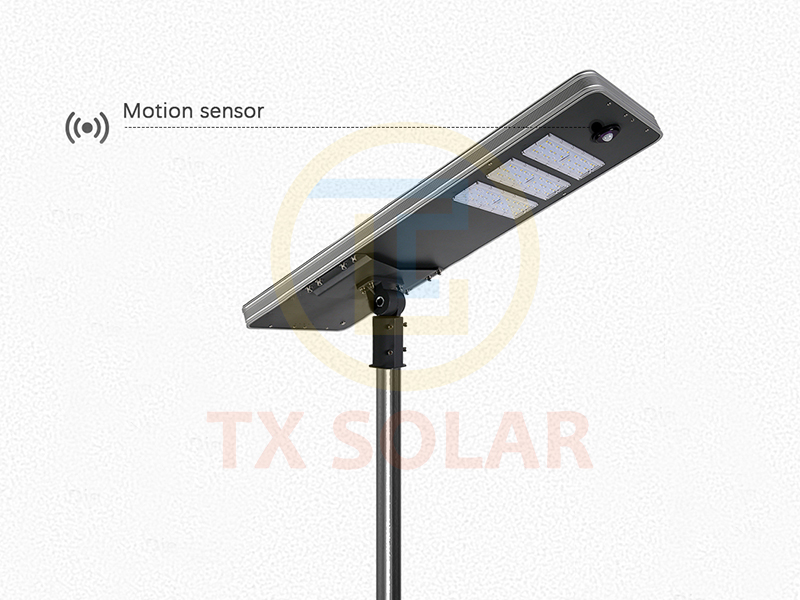In recent years, the demand for sustainable and energy-efficient solutions has surged, leading to the widespread adoption of solar technology in a variety of applications. Among them, solar street lights with motion sensors are very popular. This article explores the reasons for their increasing acceptance, their benefits, and the factors contributing to their rise in both urban and rural settings.
Rise of solar street lights
Solar street lights are outdoor lighting systems that use solar panels to harness sunlight and convert it into electricity. This technology has been around for a while, but the integration of motion sensors has revolutionized its capabilities and appeal. A motion sensor detects nearby motion, turning the lights on only when needed. This feature not only saves energy but also enhances safety in public spaces.
Environmental awareness
One of the main drivers for the popularity of solar street lights with motion sensors is the growing awareness of environmental issues. As communities work to reduce their carbon footprint, solar energy becomes a clean and renewable alternative to traditional electricity. By harnessing the power of the sun, municipalities can significantly reduce their dependence on fossil fuels, thereby contributing to a more sustainable future.
Cost effectiveness
The initial investment in solar street lights may be higher than traditional lighting systems, but the long-term cost savings are considerable. Solar street lights require minimal maintenance and have no electricity costs, making them a cost-effective solution over time. The integration of motion sensors further increases its efficiency, as the lights are only activated when necessary, thus reducing energy consumption and extending the life of the lighting system.
Enhance security
Safety is a top concern for city planners and community leaders. Solar street lights with motion sensors have a dual benefit: they illuminate areas when motion is detected, deterring potential criminal activity while ensuring pedestrians and cyclists feel safe. The ability to adjust brightness based on activity levels means these lights can provide adequate illumination without being overly bright, which could otherwise cause disruption in residential areas.
Versatility and adaptability
Solar street lights with motion sensors are versatile and can be installed in a variety of locations from busy city streets to remote rural areas. Their adaptability makes them suitable for parks, car parks, roads and residential areas. This flexibility is particularly beneficial in areas where traditional power sources are limited, where solar technology can provide reliable lighting solutions.
Technological progress
The technology behind solar street lights has advanced significantly, making them more efficient and user-friendly. Modern solar panels are more efficient at converting sunlight into electricity, and battery storage systems have improved, allowing for longer operating times even on cloudy days. Additionally, the integration of smart technologies enables remote monitoring and control, allowing municipalities to manage their lighting systems more efficiently.
Government initiatives and incentives
Many governments around the world are promoting the use of renewable energy, including solar street lights with motion sensors. Incentives such as tax breaks, grants and subsidies encourage municipalities to invest in these systems. As more cities adopt solar lighting solutions, this trend is likely to continue, further increasing their popularity.
Community engagement and aesthetics
Installing solar street lights with motion sensors often requires community involvement, as residents are consulted about their needs and preferences. This participatory approach fosters a sense of ownership and pride in public spaces. In addition, solar street lights come in a variety of designs and styles, allowing communities to choose options that enhance the aesthetics of their community.
Challenges and considerations
Despite their many advantages, solar street lights with motion sensors also face challenges. Initial costs can be a barrier for some cities, especially those with limited budgets. Additionally, the effectiveness of solar lights may be affected by geographic location, weather conditions, and the amount of sunlight received. Proper planning and site assessment are critical to ensuring these systems meet the lighting needs of a specific area.
Future of solar street lights with motion sensors
As technology continues to develop, the future of solar street lights with motion sensors looks promising. Innovations in battery technology, solar panel efficiency and smart city integration are likely to enhance their functionality and appeal. Additionally, the demand for solar street lights with motion sensors is expected to grow as more communities realize the benefits of sustainable lighting solutions.
In conclusion
Solar street lights with motion sensors are becoming increasingly popular due to their environmental benefits, cost-effectiveness, enhanced safety and adaptability. As communities prioritize sustainability and energy efficiency, these innovative lighting solutions will play an important role in urban and rural development. With continued advancements in technology and supportive government initiatives, the future of solar street lights with motion sensors is bright, lighting the way to a greener and safer world.
Post time: Nov-06-2024

